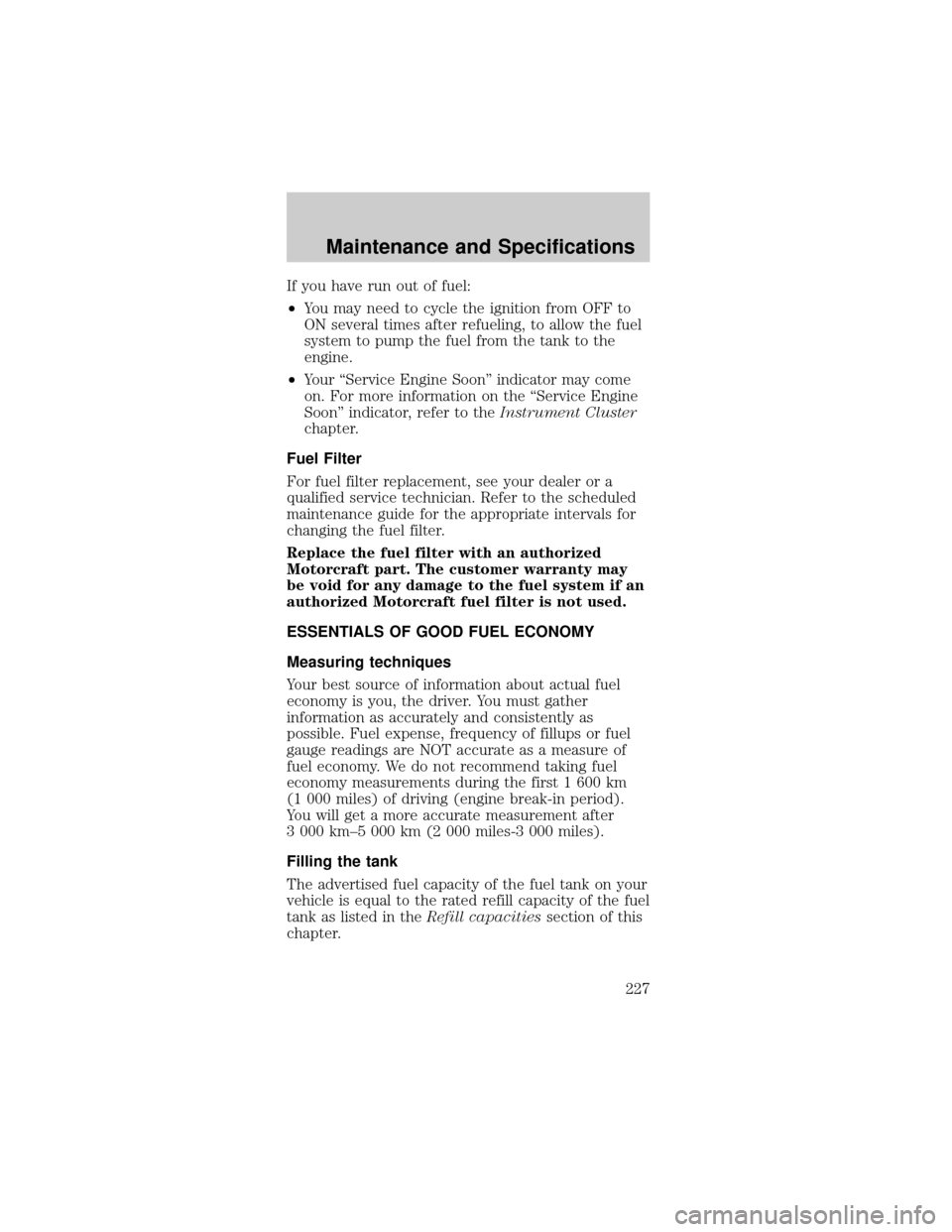Page 227 of 264

If you have run out of fuel:
²You may need to cycle the ignition from OFF to
ON several times after refueling, to allow the fuel
system to pump the fuel from the tank to the
engine.
²Your ªService Engine Soonº indicator may come
on. For more information on the ªService Engine
Soonº indicator, refer to theInstrument Cluster
chapter.
Fuel Filter
For fuel filter replacement, see your dealer or a
qualified service technician. Refer to the scheduled
maintenance guide for the appropriate intervals for
changing the fuel filter.
Replace the fuel filter with an authorized
Motorcraft part. The customer warranty may
be void for any damage to the fuel system if an
authorized Motorcraft fuel filter is not used.
ESSENTIALS OF GOOD FUEL ECONOMY
Measuring techniques
Your best source of information about actual fuel
economy is you, the driver. You must gather
information as accurately and consistently as
possible. Fuel expense, frequency of fillups or fuel
gauge readings are NOT accurate as a measure of
fuel economy. We do not recommend taking fuel
economy measurements during the first 1 600 km
(1 000 miles) of driving (engine break-in period).
You will get a more accurate measurement after
3 000 km±5 000 km (2 000 miles-3 000 miles).
Filling the tank
The advertised fuel capacity of the fuel tank on your
vehicle is equal to the rated refill capacity of the fuel
tank as listed in theRefill capacitiessection of this
chapter.
Maintenance and Specifications
227
Page 228 of 264

The advertised capacity is the amount of the
indicated capacity and the empty reserve combined.
Indicated capacity is the difference in the amount of
fuel in a full tank and a tank when the fuel gauge
indicates empty. Empty reserve is the small amount
of fuel remaining in the fuel tank after the fuel
gauge indicates empty.
The amount of usable fuel in the empty reserve
varies and should not be relied upon to
increase driving range. When refueling your
vehicle after the fuel gauge indicates empty,
you might not be able to refuel the full amount
of the advertised capacity of the fuel tank due
to the empty reserve still present in the tank.
For consistent results when filling the fuel tank:
²Turn the engine/ignition switch to the off position
prior to refueling, an error in the reading will
result if the engine is left running.
²Use the same filling rate setting (low Ð medium
Ð high) each time the tank is filled.
²Allow no more than 2 automatic click-offs when
filling.
²Always use fuel with the recommended octane
rating.
²Use a known quality gasoline, preferably a
national brand.
²Use the same side of the same pump and have
the vehicle facing the same direction each time
you fill up.
²Have the vehicle loading and distribution the
same every time.
Your results will be most accurate if your filling
method is consistent.
Maintenance and Specifications
228
Page 260 of 264

The Dispute
Settlement Board . 183
Utilizing the
Mediation/Arbitration
Program ................. 187
D
Daytime running lamps
(see Lamps) .............. 71
Defrost
rear window ............ 70
Dipstick
automatic transmission
fluid ........................ 238
engine oil ............... 206
Doors
lubricant
specifications ........ 249
Driving under special
conditions
through water ....... 158
E
Emergencies, roadside
jump-starting ........ 174
Emission control
system ...................... 232
Engine ...................... 251
check engine/service
engine soon light .... 11
cleaning ................. 194
coolant ................... 213
idle speed control.. 210
lubrication
specifications. 249, 251
refill capacities ...... 247
service
points ............. 204±205starting after
a collision .............. 164
Engine block
heater ....................... 140
Engine oil ................ 206
checking and
adding .................... 206
dipstick .................. 206
filter,
specifications. 209, 246
recommendations... 209
refill capacities ...... 247
specifications. 249, 251
Exhaust fumes ........ 140
F
Floor mats ................. 90
Fluid capacities ....... 247
Foglamps ................... 71
Fuel .......................... 221
calculating fuel
economy ................ 227
cap ................... 13, 224
capacity ................. 247
choosing the
right fuel ................ 225
comparisons with EPA
fuel economy
estimates ............... 231
detergent in fuel ... 226
filling your vehicle
with
fuel
......... 221, 224, 227
filter,
specifications. 227, 246
fuel pump shut-off
switch .................... 164
gauge ....................... 18
improving fuel
economy ................ 227
Index
260